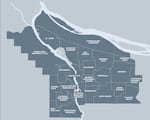The average Black household, with a median annual income of $31,538, could not afford the typical rent in any Portland neighborhood in 2020. The average Latinx family, with a median income of $52,573, could likely afford to purchase a home only in East Portland. And the average Native American household, with a median income of $45,086, would struggle to afford to buy a home anywhere in the city.
That’s according to a new report on Portland’s 2020 housing market. The analysis, which will be presented to the city council Wednesday, found the city’s housing prices have continued a rapid ascent while the incomes of residents of color made only modest gains.
“The 2020 State of Housing in Portland Report continues to show that housing affordability (both rental and homeownership) remains a challenge as rents and home prices continue to climb — outpacing incomes,” the report states.
The Portland Housing Bureau has produced the State of Housing report every year since 2015. In the report’s forward, Commissioner Dan Ryan, who oversees the housing bureau, wrote that the analysis is intended to show “who the housing market is serving and who is being left behind.”
The report found that Portland continues to diversify with the number of residents of color continuing to grow in outer East, Northeast, and Southeast Portland, according to the latest available census data. Yet it is residents of color who remain most at risk of being priced out of the city entirely.
“We continue to see a housing market where for communities of color, seniors, immigrants, for single parents, it’s extremely hard to find affordable housing or to be stabilized in your housing,” said Matthew Tschabold, policy and planning manager for the housing bureau. “Those are the communities that continued to struggle.”
The report uses data from commercial real estate tracking firm CoStar to determine the average rent for a studio, one-bedroom, two-bedroom, and three-bedroom in 2020 in 24 areas of Portland. (You can see how the city broke up neighborhood boundaries in the map below.) The report’s authors considered a neighborhood unaffordable for a demographic group if the average rent for a unit exceeded 30% of the median monthly income for that group. Income data for Latinx, Black, Native American, white, Asian and Hawaiian and Pacific Islander households came from the American Community Survey 2017 5-Year Income Estimates. This means it does not take into account the economic impacts of the pandemic, which has disproportionately impacted communities of color.

Portland State of Housing Report
According to the analysis, the average Black family could not afford to rent a three-bedroom, two-bedroom, or one-bedroom in any Portland neighborhood. A studio would be considered affordable in just two areas of Portland: 122nd-Division and Raleigh Hills. The average Native American household could afford to rent a two-bedroom only in four neighborhoods in Northeast and East Portland.
The findings were not all negative. Some communities of color saw income gains and new neighborhoods open up as a result. For the first time since the report was commissioned in 2015, the authors found the average Latinx and Pacific Islander household could afford to rent a two-bedroom home in a majority of Portland neighborhoods.
But Tschabold warned these improvements could be wiped out by the pandemic.
“We saw some affordability gains from some communities, but there’s an open question now as to whether or not those gains will be entirely reversed by the economic impact of the Covid pandemic,” he said.
The report found white households, with a median income of $70,391, have the most success in the current housing market, able to afford a two-bedroom rental in most neighborhoods outside the center city.
The report also found the city has become slightly more affordable for renters overall. Since the start of the pandemic, there was a slight drop in rent citywide - a change in course from the steady increases of the past decade that have contributed to the city’s housing crisis. The average rent in 2020 was $1,461 per month, according to the report — $14 cheaper per month than in 2019.
But the rent decreases were not evenly distributed across the city. While six areas saw 2020 dips in average rent — Belmont-Hawthorne-Division, Central City, Forest Park, Northwest, South Portland and Woodstock — four areas saw big rent jumps of more than 5% — Hayden Island, Parkrose, Raleigh Hills and West Portland.
Meanwhile, home prices have continued to skyrocket. Between 2014 and 2019, the authors found median home sales prices increased citywide by over $88,000. Some of the biggest increases have taken place in East Portland, where the report’s authors warned of “serious concerns about displacement and housing stability” of residents.
The report will be presented to the city council at 10:30 a.m. Wednesday.
